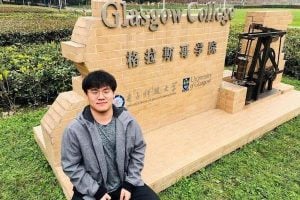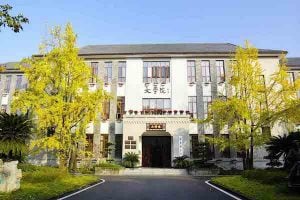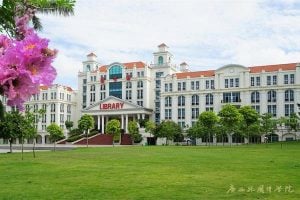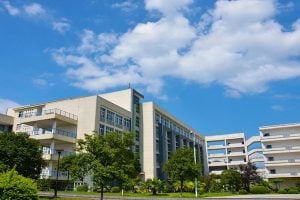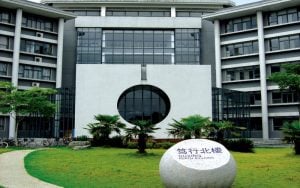University of Chinese Academy of Sciences
 |
 |
 |
 |
Introduction to University of Chinese Academy of Sciences
The University of Chinese Academy of Sciences (中国科学院大学, website) is an innovative university characterized by “learning with lofty ideals and wise knowledge” as a school motto and featuring the integration of science and education.
The University of Chinese Academy of Sciences, formerly the Graduate School of the Chinese Academy of Sciences, was established in 1978. It was the first graduate school to be established with the approval of the Party Central Committee and the State Council. Female doctors, the first dual-degree doctorate. In June 2012, the Ministry of Education approved the rename of the Graduate School of the Chinese Academy of Sciences to the University of Chinese Academy of Sciences. In 2014, the National University of Science and Technology began to recruit undergraduates, and formed a higher education system covering three levels: basic, master, and Ph.D.
As of December 2018, the university has more than 3,000 full-time teachers, of which 138 are academicians of the two academies, and 375 have been awarded by the National Science Foundation for Distinguished Young Scholars. Each postgraduate training unit has 11,737 postgraduate supervisors, including 240 academicians of the two academicians. More than 6,600 doctoral supervisors.
As of December 2018, the university has 1,541 undergraduate students; 49,000 graduate students, of which 52% are doctoral students, the number of doctoral students ranks first in the country, and one-third of doctoral students in science; 1757 foreign students studying From 100 countries, including 1,050 foreign doctoral students, the number of foreign doctoral students ranked first in the country’s universities.
The University of Chinese Academy of Sciences consists of four campuses (Yuquan Road, Zhongguancun, Olympic Village, Yanqi Lake), five education bases (Shanghai, Wuhan, Guangzhou, Chengdu, Lanzhou) and 116 training units distributed throughout the country. In recent years, the National University of Science and Technology has continued to deepen the reform of the system and mechanism of science and education integration and organizational construction, and “co-construct, co-govern, share, and win-win” with various training units. As of 2018, the school has a total of 55 teaching and research units directly under the school, including 40 in Beijing and 15 outside Beijing; and 7 affiliated hospitals.
The University of Chinese Academy of Sciences is an important bearer of the Chinese Academy of Sciences’ “first to build a national highland for innovative talents” mission, and an important support for fulfilling the strategic mission of “outcomes, talents, and ideas.” The core mission of the school is to use the science-education integration platform to select the best education and teaching resources of the Chinese Academy of Sciences, provide it to graduate students and undergraduates, cultivate scientific and technological innovation and entrepreneurial talents with both merits and talents, serve the country’s innovation-driven development, and serve the human civilization. make a contribution. As of December 2018, the National University of Science and Technology has awarded a total of 160,614 postgraduate master’s and doctoral degrees, of which 77,853 have been awarded doctoral degrees; for the first time, 290 undergraduate graduates have been awarded. The National University of Science and Technology has trained about a quarter of the “Outstanding Youth Fund Winners”. Since its establishment in 1978, 108 students have been elected as academicians of the Chinese Academy of Sciences and Chinese Academy of Sciences.
The University of Chinese Academy of Sciences insists on cultivating innovative and entrepreneurial talents in high-level scientific research practices. Graduate students have become the new force of national scientific and technological innovation. The major achievements and outputs of the Chinese Academy of Sciences have their contributions and contributions. 23 national major science and technology infrastructures, one national laboratory, two national research centers, 77 national key laboratories, 189 Chinese Academy of Sciences key laboratories, 9 national engineering research centers, and 17 The National Engineering Technology Research Center, 15 national engineering laboratories, and many state-level cutting-edge scientific research projects provide a world-class scientific research and innovation platform for student training.
The university has abundant literature resources and modern teaching conditions. The National University of Science and Technology shares the resources of the Literature and Information Center of the Chinese Academy of Sciences, with rich collection resources and electronic documents. Students can consult various professional documents in the libraries of the various branches and institutes of the Chinese Academy of Sciences and the libraries of Yanqi Lake Campus and Yuquan Road Campus of the National University of Science .
The university has excellent teaching facilities, and comprehensively applies modern teaching methods such as multimedia and online video education. The National University of Science and Technology has paid close attention to teaching quality, strict teaching management, strengthened the construction of teaching staff, and published a large number of high-level professional teaching materials.
The University of Chinese Academy of Sciences has a complete discipline system, with a total of 40 first-level disciplines authorized by doctorates, which are distributed in 7 disciplines of philosophy, education, science, engineering, agronomy, medicine, and management. There are 53 disciplines in 10 disciplines including philosophy, economics, law, education, literature, science, engineering, agriculture, medicine, and management. In addition, the National University of Science and Technology also has 10 types of professional degree authorization points in engineering, business administration, finance, applied statistics, applied psychology, translation, agriculture, pharmacy, engineering management, and public management, of which 22 degrees are authorized for engineering master degrees. While maintaining the discipline advantage in the field of natural sciences, the National University of Science and Technology has continuously strengthened the construction of applied disciplines, emerging interdisciplinary disciplines, and humanities and social science disciplines in recent years. Its strengths in management science, philosophy, medicine, psychology, economics, law and other disciplines Also gradually appeared.
The university is one of the 20 universities authorized by the State Council Degree Office to independently review degrees. According to the results of the fourth round of national disciplinary evaluations, 30 disciplines of the National University of Science and Technology were rated as Class A, of which 18 were A + disciplines. In the latest data of ESI (Essential Science Indicators) released in January 2019, the National University of Science and Technology ranks 88th, Ranked first in mainland universities. Among all 22 subject rankings, the National University of Science and Technology’s materials science and chemistry ranks among the top 10,000th of ESI; materials science, chemistry, environmental science and ecology, engineering, plant and animal science, agriculture, and earth science enter 7 disciplines One thousandth of ESI, 17 disciplines are selected as one hundredth of ESI.
Relying on the rich scientific and educational resources of the Chinese Academy of Sciences and the strong international cooperation platform, the University of Chinese Academy of Sciences carries out diverse and rich international academic cooperation and teacher-student exchange work, and continuously improves the school’s international academic reputation and international influence. At present, the National University of Science and Technology has cooperated with Harvard University, MIT, Columbia University, Stanford University, Cambridge University, Bristol University, Technical University of Munich, Germany, National University of Australia, Sorbonne University of France, Paris University of Science and Arts and Humanities World-class universities such as the University of Toronto, the National University of Singapore, and the Royal Academy of Sciences, the Max Planck Society of Germany, the National Research Center of France, and the American Academy of Sciences have established close contacts and cooperative exchanges. National University of Science and Technology is a member university of the Pacific Rim University Alliance (APRU) and one of the founding universities of the University of Science and Technology Alliance (UAST).
With the support of the Chinese Academy of Sciences and the Danish Ministry of Science and Education, the University of Chinese Academy of Sciences and 8 Danish universities jointly created a “China-Danish Center” that integrates education and scientific research innovation, and established a Sino-foreign cooperatively-run school-“Zhongdan College “. The National Natural Science Foundation of China and the International Center for Theoretical Physics (ICTP) will build the International Center for Theoretical Physics (Asia-Pacific) under UNESCO. With the support of the Kavli Foundation in the United States, the Kavli Institute of the National University of Science and Technology has been established and has become one of the 20 Kavli Institutes in the world today.
The University actively promotes the joint construction of the “Belt and Road” education action, participates in the “Chinese Academy of Sciences developing country science and education cooperation and expansion project”, implements the “Chinese Academy of Sciences-Developing Academy of Sciences Scholarship” and “Chinese Academy of Sciences Belt and Road” Master Scholarship Plan to train foreign high-level young scientific and technological talents.
Facing the future, the National University of Science and Technology will adhere to the direction of running a socialist school and rely on the construction of the Huairou Comprehensive National Science Center to gather first-class teachers, build a first-class discipline system, produce first-class innovation results, and cultivate first-class innovative talents. By 2020, the National University of Science and Technology will enter the ranks of world-class influential research universities; by 2035, it will rank among the world’s top research universities; by 2050, it will rank among the world’s top innovative universities. Scientific and technological innovation has explored a mature road with unique characteristics, integration of science and education, and collaborative innovation, and has made indispensable contributions to the great rejuvenation of the Chinese nation and the advancement of science and technology in the world….
Teaching Program
![]() ISAC University Teaching Program
ISAC University Teaching Program
Related Universities


